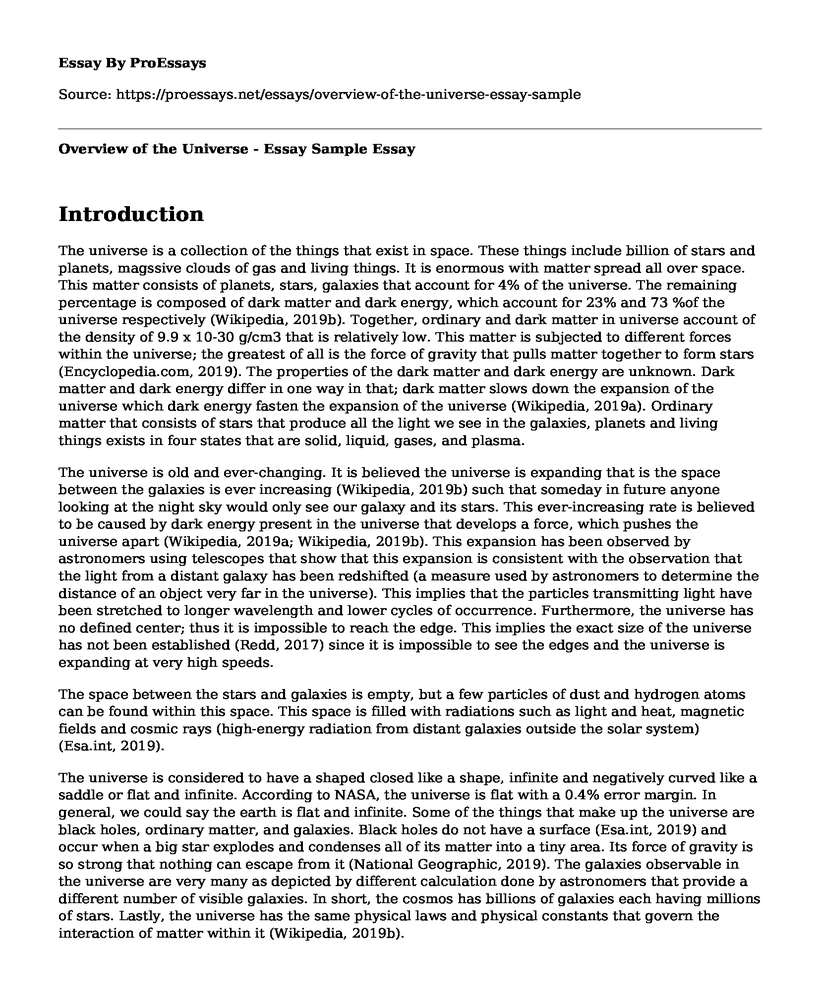Introduction
The universe is a collection of the things that exist in space. These things include billion of stars and planets, magssive clouds of gas and living things. It is enormous with matter spread all over space. This matter consists of planets, stars, galaxies that account for 4% of the universe. The remaining percentage is composed of dark matter and dark energy, which account for 23% and 73 %of the universe respectively (Wikipedia, 2019b). Together, ordinary and dark matter in universe account of the density of 9.9 x 10-30 g/cm3 that is relatively low. This matter is subjected to different forces within the universe; the greatest of all is the force of gravity that pulls matter together to form stars (Encyclopedia.com, 2019). The properties of the dark matter and dark energy are unknown. Dark matter and dark energy differ in one way in that; dark matter slows down the expansion of the universe which dark energy fasten the expansion of the universe (Wikipedia, 2019a). Ordinary matter that consists of stars that produce all the light we see in the galaxies, planets and living things exists in four states that are solid, liquid, gases, and plasma.
The universe is old and ever-changing. It is believed the universe is expanding that is the space between the galaxies is ever increasing (Wikipedia, 2019b) such that someday in future anyone looking at the night sky would only see our galaxy and its stars. This ever-increasing rate is believed to be caused by dark energy present in the universe that develops a force, which pushes the universe apart (Wikipedia, 2019a; Wikipedia, 2019b). This expansion has been observed by astronomers using telescopes that show that this expansion is consistent with the observation that the light from a distant galaxy has been redshifted (a measure used by astronomers to determine the distance of an object very far in the universe). This implies that the particles transmitting light have been stretched to longer wavelength and lower cycles of occurrence. Furthermore, the universe has no defined center; thus it is impossible to reach the edge. This implies the exact size of the universe has not been established (Redd, 2017) since it is impossible to see the edges and the universe is expanding at very high speeds.
The space between the stars and galaxies is empty, but a few particles of dust and hydrogen atoms can be found within this space. This space is filled with radiations such as light and heat, magnetic fields and cosmic rays (high-energy radiation from distant galaxies outside the solar system) (Esa.int, 2019).
The universe is considered to have a shaped closed like a shape, infinite and negatively curved like a saddle or flat and infinite. According to NASA, the universe is flat with a 0.4% error margin. In general, we could say the earth is flat and infinite. Some of the things that make up the universe are black holes, ordinary matter, and galaxies. Black holes do not have a surface (Esa.int, 2019) and occur when a big star explodes and condenses all of its matter into a tiny area. Its force of gravity is so strong that nothing can escape from it (National Geographic, 2019). The galaxies observable in the universe are very many as depicted by different calculation done by astronomers that provide a different number of visible galaxies. In short, the cosmos has billions of galaxies each having millions of stars. Lastly, the universe has the same physical laws and physical constants that govern the interaction of matter within it (Wikipedia, 2019b).
References
Encyclopedia.com. (2019). Universe | Encyclopedia.com. Retrieved from https://www.encyclopedia.com/science-and-technology/astronomy-and-space-exploration/astronomy-general/universe
Esa.int. (2019). ESA - Space for Kids - The Universe. Retrieved from https://www.esa.int/kids/en/learn/Our_Universe/Story_of_the_Universe/The_Universe
National Geographic. (2019). Universe Facts | National Geographic Kids. Retrieved from https://www.natgeokids.com/uk/discover/science/space/universe-facts/
Redd, N. (2017). How Big is the Universe?. Retrieved from https://www.space.com/24073-how-big-is-the-universe.html
Wikipedia. (2019a). Universe. Retrieved from https://en.wikipedia.org/wiki/Universe#Shape
Wikipedia. (2019b). Universe. Retrieved from https://simple.wikipedia.org/wiki/Universe
Cite this page
Overview of the Universe - Essay Sample. (2022, Dec 10). Retrieved from https://proessays.net/essays/overview-of-the-universe-essay-sample
If you are the original author of this essay and no longer wish to have it published on the ProEssays website, please click below to request its removal:
- Chemical Oscillators
- Research on Extraterrestrial Life
- Was Moon Landing a Hoax or Did It Actually Occur? - Paper Example
- Influence of Geography on Civilization Essay
- Essay Sample on Genetic Mutation
- Essay Example on Metaphysics: Exploring Abstract Objects & Phenomena
- The Universe: The Home of Galaxies - Essay Sample







